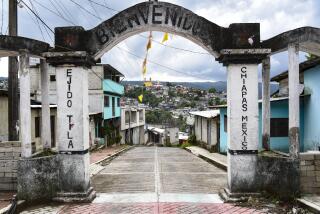Granjenal’s Life Ebbs With Exodus
- Share via
GRANJENAL, Mexico — To remind himself that he is not forgotten, parish priest Javier Castro keeps a 3-foot-tall trophy from the Orange County Soccer League at the foot of his desk.
His boys won the championship in 1992. They carried their prize 1,500 miles back to this picturesque farming town in northern Michoacan state, handed it to Castro and celebrated for a week.
Then they went home to Santa Ana, where so many of Granjenal’s people have gone.
Castro’s town is nearly empty, the streets overrun with cows, the brightly colored houses mostly vacant and padlocked.
In the last decade, the elementary school has lost three-fourths of its children, businesses have withered and Castro’s dwindling congregation barely justifies a full-time priest: He baptized only six children last year and hasn’t performed a wedding in five months.
From a village of several thousand, Granjenal (pronounced gran-HEY-nal) has shrunk to a few hundred residents, making it, in the words of Mexican migration researcher Gustavo Lopez Castro, “the loneliest town in Michoacan.”
An hour’s drive up winding dirt roads from the nearest highway, Granjenal lies in a dry valley surrounded by scrub-covered hills and parched farmland. Almost from its founding near the turn of the century, Lopez says, Granjenal’s workers have immigrated to California. They came and went in waves that coincided with U.S. economic fortunes, immigration laws and Mexican agricultural policies. But most continued to call Mexico home.
What set off the California exodus from this town, and scores of others across central Mexico, was a 1986 U.S. immigration law that granted amnesty to about 3 million undocumented workers, including hundreds from Granjenal. Once legal, many set down roots in the north and sent for their families.
Nearly everyone who left Granjenal went to Santa Ana, a base for the town’s migrant workers since the 1960s. There, most found low-skilled construction jobs in Orange County through the Laborers Union at Grand and Chestnut avenues.
In Father Castro’s opinion, the migration was a huge mistake. He knows this, he says, because every year he too packs his bags and heads north to visit his parishioners in Orange County.
Granjenal’s people, he says, traded open space and innocence for crowded apartments, financial pressures, fear and isolation in urban Santa Ana.
But Castro’s assessment is a hard sell in a Mexican town with poor farmland dependent on unreliable rains, a shortage of jobs, one telephone and a school that goes only to the sixth grade.
Few who stayed in Granjenal have prospered, while many sons and daughters of those who went north have moved on to careers or office jobs that pay more in a week than a Mexican farm worker earns in six months.
“Of course, we would stay here if we could,” says Antonio Lopez, a portly man with a mass of gray hair who first went north 38 years ago but who returns periodically; he now serves as Granjenal’s honorary mayor. “But what choice did we have? There is no work in Granjenal.”
Of course, Lopez adds, the link to Santa Ana has benefited the town. Contributions helped build the school, bring electricity and running water, and pave two main roads with concrete. They also financed a small bullring, rebuilt the church and paid for a central plaza with wrought-iron benches.
‘How Bored I Am Here’
Many of Granjenal’s colorful adobe houses were upgraded and furnished with dollars earned in Santa Ana. But scores of the houses have been vacant for years, and aside from visits during the holidays, most may never be inhabited again. The owners, who once dreamed of a tranquil retirement in Granjenal, prefer to face old age with their children and grandchildren in Orange County.
The town’s new plaza, of which Lopez is so proud, stands empty most afternoons. Infested with weeds and encircled by barbed wire to keep out hungry cows, it is a tribute to Granjenal’s fleeting taste of prosperity, and to its slow but inexorable death.
Granjenal was named for the gnarled, olive-like granjeno trees that were once abundant here. Cut for firewood, the trees, like Granjenal’s people, have all but disappeared.
“Ay, you can’t imagine how bored I am here,” says Rosa Guillen, who is married to the honorary mayor.
Guillen tends a small grocery store facing the empty plaza, but for an hour she has had no customers. She says she opened the business as a hobby.
“Something to do until I go back to Santa Ana to be with my children,” Guillen says, fanning herself with a scrap of brown wrapping paper. “If I didn’t have this, I would go crazy.”
Outside, in the sun-drenched afternoon, four middle-aged women stand under umbrellas and chat in the concrete street. The only traffic is a burro carrying a load of scavenged firewood, accompanied by three chortling men who trade turns on the animal’s back.
A block away, in the vacant jail that doubles as an afternoon gathering spot, six of Granjenal’s more prosperous men play a friendly game of poker, their white cowboy hats pushed back on their heads.
Among them is Melchor Maldonado, a smooth-talking pig trader whose negotiating skills have made him relatively wealthy.
The only one of eight brothers to remain in Granjenal, Maldonado trades pigs in the morning, plays cards in the afternoon and watches the evening news on television.
He wonders what his town might have been like if most of its strongest, smartest and most ambitious men had stayed. And he worries that when the men and women of his generation die, the connection to Santa Ana will die with them.
“There were 20 or 30 good years,” he says, remembering when workers sent home monthly money orders and returned for a few months every winter. “There was a lot of money here, and we would have liked it to continue. But that ended with the amnesty.”
Not everyone remembers those prosperous days with fondness. It was a lonely life for the migrant workers, who spent most of the year separated from their families, crowded into cramped Santa Ana apartments. The life was equally hard on those left behind.
For workers crossing the border illegally--the majority before amnesty--the journey was difficult and often dangerous.
In 1985, a 23-year-old man from Granjenal was hit by a car and killed as he ran from Border Patrol agents near the San Diego border.
A year later, construction worker Elias Leon Chavez was robbed, beaten and left for dead during a nighttime crossing at the Tijuana River channel. The father of four never went north again.
These days, he scrapes together a living doing odd jobs and works, in painstakingly slow stages, on his concrete house. “I save for a few months, and I buy a bag of cement,” he says. “Then I can build a wall.”
A few workers returned because they hated life in the north--the constant fear of deportation, the loneliness, the early mornings and long days of back-straining labor. Jorge Valencia is one of them.
Valencia worked in Santa Ana in the mid-’70s. Like most of his friends, he crossed the border illegally and quickly found a construction job through the laborers’ union.
But waking at 4 a.m. to make the long daily drive to the work site in southern Orange County wore on him, and after three years he decided to stay in Mexico.
Now Valencia, whose eight brothers and sisters live in Orange County, supports his wife and six children by running a grocery store and doing odd jobs when he can find them.
While stacking blocks for the new wall of a neighbor’s house one morning, he tips his Mighty Ducks cap and jokes with a friend that he misses the “greenery” of California--referring to dollars.
“There’s nothing here anymore,” he says. “No work. No people. No money.”
Unwanted Influences
In this town where most adults have no more than a fourth-grade education, nearly everyone can explain the complex economic forces that led to Granjenal’s abandonment.
They talk about the poor-quality farmland doled out during Mexico’s agrarian reform in the 1930s, about their increasing dependency on expensive fertilizers, about the crash of international pork prices 10 years ago that eliminated a small but reliable source of income for many families.
They shake their heads over Mexico’s abrupt move to a free-market economy in the early ‘90s, when price supports for seeds and fertilizers were eliminated, along with government-backed loans and credits. U.S. imports caused corn prices to plummet.
The people of Granjenal also speak with authority about fickle U.S. immigration laws and cycles of prosperity in the north.
When amnesty made possible the legal emigration of entire families, few hesitated.
Census figures are unreliable, but researchers and former residents say nearly 3,000 people lived in Granjenal at its peak in the 1970s. Now there are fewer than 500.
A tough U.S. border policy, in effect for three years, may once again change the face of Granjenal. Several young men, stranded in town after failed attempts to cross the border, say that they were blocked by a phalanx of federal agents, and that the cost of a smuggler’s aid has soared from $200 five years ago to $1,000.
If caught twice, there is a heavy price: Two men from Granjenal are serving time in federal prison for trying to reenter the United States after deportation.
But even as Santa Ana becomes more difficult to reach, its unwanted influences have gained a foothold in Granjenal.
Graffiti from a Santa Ana gang is etched into the wall of an abandoned house in town. At a nearby reservoir, two teenagers with shaved heads and gang tattoos lead a platoon of admiring youngsters.
“Just hangin’ with my homies,” says a 14-year-old boy whose two stepbrothers were killed in Santa Ana gang shootings.
He is one more piece of evidence that, for better and for worse, Santa Ana and Granjenal have become irrevocably linked.
That joined history even permeates a nightly religious ritual Father Castro started 10 years ago.
Neighbors gather for an hour of chanting and prayer before a flower-adorned altar of the Virgin of Guadalupe, the town’s patroness. The altar is moved every two days from house to house, until everyone remaining in Granjenal has hosted the event at least once. Then the cycle repeats.
On this night, as votive candles flicker, those seated in the darkened kitchen recite the rosary in a hypnotic murmur.
They close with a song written by Father Castro to all those who have gone:
“Morenita, mi morena, tu no te olvides de mi. En Granjenal o en Santa Ana, tu te has de acordar de mi.” (Dark Virgin, my dark one, you must not forget me. In Granjenal or in Santa Ana, you must remember me.)
NEXT: Life in Santa Ana
More to Read
Sign up for Essential California
The most important California stories and recommendations in your inbox every morning.
You may occasionally receive promotional content from the Los Angeles Times.










